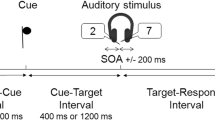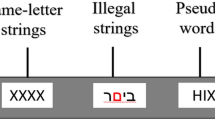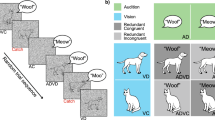Abstract
In the current study, participants judged as ‘low’ or ‘high’ either the location or the frequency of a single tone presented in one of two locations at one of two frequencies. The classification associated with the irrelevant feature could be either congruent or incongruent with the required response. The results of Experiment 1 revealed that responses were made more slowly on incongruent than on congruent trials, regardless of whether participants judged sounds according to their location or their pitch. In Experiment 2, we manipulated the probability that the classification associated with the irrelevant acoustic feature was consistent with the classification associated with the task-relevant dimension. In this experiment responses were made more quickly on congruent trials when the response associated with the irrelevant feature was likely to be consistent with the required response, and on incongruent trials when the response associated with the irrelevant feature was likely to be inconsistent with the required response.

Similar content being viewed by others
References
Adam, J. J., Boon, B., Paas, F. G. W. C., & Umiltà, C. (1998). The up-right/down-left advantage for vertically oriented stimuli and horizontally oriented responses: A dual-strategy hypothesis. Journal of Experimental Psychology: Human Perception and Performance, 24, 1582–1595
Adobe Systems Incorporated (2005). Adobe Audition 1.5. San Jose, CA
Bauer, D. W., & Miller, J. (1982). Stimulus–response compatibility and the motor system. Quarterly Journal of Experimental Psychology, 34A, 367–380
Besner, D., & Stolz, J. A. (1999). Unconsciously controlled processing: The Stroop effect reconsidered. Psychonomic Bulletin and Review, 6, 449–455
Broadbent, D. E. (1954). The role of auditory localization in attention and memory span. Journal of Experimental Psychology, 47, 191–196
Cherry, C. (1953). Some experiments on the recognition of speech with one and with two ears. Journal of the Acoustical Society of America, 25, 975–979
Cho, Y. S., & Proctor, R. W. (2004). Stimulu-set location does not affect orthogonal stimulus–response compatibility. Psychological Research, 69, 106–114
Cohen, J. D., Dunbar, K., & McClelland, J. L. (1990). On the control of automatic processes: A parallel distributed processing model of the Stroop effect. Psychological Review, 97, 332–361
Danziger, S., Estevez, A. F., & Mari-Beffa, P. (2002). Stroop interference effects in partially colored Stroop words. Psychonomic Bulletin and Review, 9, 536–541
Green, E. J., & Barber, P. J. (1981). An auditory Stroop effect with judgments of speaker gender. Perception and Psychophysics, 30, 459–466
Green, E. J., & Barber, P. J. (1983). Interference effects in an auditory Stroop task: Congruence and correspondence. Acta Psychologica, 53, 183–194
Hall, M. D., & Blasko, D. G. (2005). Attentional interference in judgments of musical timbre: Individual differences in working memory. The Journal of General Psychology, 132, 94–112
Hamers, J. F., & Lambert, W. E. (1972). Bilingual interdependencies in auditory perception. Journal of Verbal Learning and Verbal Behaviour, 11, 303–310
Hintzman, D. L. (1976). Repetition and memory. In G. H. Bower (Ed.), The Psychology of Learning and Motivation (pp. 47–91). New York: Academic
Jacoby, L. L. (1978). On interpreting the effects of repetition: Solving a problem versus remembering a solution. Journal of Verbal Learning and Verbal Behavior, 17, 649–667
Jacoby, L. L., & Brooks, L. R. (1984). Nonanalytic cognition: Memory, perception and concept formation. Psychology of Learning and Motivation, 18, 1–47
Jacoby, L. L., Lindsay, D. S., & Hessels, S. (2003). Item-specific control of automatic processes: Stroop process dissociations. Psychonomic Bulletin and Review, 10(3), 638–644
Kahneman, D., & Henik, A. (1981). Perceptual organization and attention. In M. Kubovy & J. R. Pomerantz (Eds.), Perceptual Organization (pp. 181–211). Hillsdale: Erlbaum
Kornblum, S., Hasbroucq, T., & Osman, A. (1990). Dimensional overlap: Cognitive basis for stimulus–response compatibility—a model and taxonomy. Psychological Review, 97, 253–270
LaBerge, D., & Samuels, S. J. (1974). Toward a theory of automatic information processing in reading. Cognitive Psychology, 6, 293–323
Lindsay, D. S., & Jacoby, L. L. (1994). Stroop process dissociations: The relationship between facilitation and interference. Journal of Experimental Psychology: Human Perception & Performance, 20, 219–234
Logan, G. D. (1988). Toward an instance theory of automatization. Psychological Review, 95, 492–527
Logan, G. D. (2002). An instance theory of attention and memory. Psychological Review, 109, 376–400
Logan, G. D., Zbrodoff, N. J., & Williamson, J. (1984). Strategies in the color-word Stroop task. Bulletin of Psychonomic Society, 22, 135–138
MacLeod, C. M. (1991). Half a century of research on the Stroop effect: an integrative review. Psychological Bulletin, 109, 163–203
MacLeod, C. M. (1998). Training on integrated versus separated Stroop tasks: The progression of interference and facilitation. Memory & Cognition, 26, 201–211
MacLeod, C. M., & MacDonald, P. A. (2000). Interdimensional interference in the Stroop effect: uncovering the cognitive and neural anatomy of attention. Trends in Cognitive Sciences, 4, 383–391
MacLeod, C. M., & Dunbar, K. (1988). Training and Stroop-like interference: evidence for a continuum of automaticity. Journal of Experimental Psychology: Learning, Memory, and Cognition, 10, 304–315
Martino, G., & Marks, L. E. (1999). Perceptual and linguistic interactions in speeded classification: Tests of semantic coding hypothesis. Perception, 28, 903–923
Martino, G., & Marks, L. E. (2001). Synethesia: strong and weak. Current Directions in Psychological Science, 10, 61–65
McClain, L. (1983). Stimulus–response compatibility affects auditory Stroop interference. Perception & Psychophysics, 33, 266–270
Mondor, T. A., Zatorre, R. J., & Terrio, N. A. (1998). Constraints on the selection of auditory information. Journal of Experimental Psychology: Human Perception and Performance, 24, 66–79
Morgan, A. L. R., & Brandt, J. F. (1989). An auditory Stroop effect for pitch, loudness, and time. Brain and Language, 36, 592–603
Neely, J. H., & Kahan, T. A. (2001). Is semantic activation automatic? A critical re-evaluation. In H. L. Roediger III, J. S. Nairne, I. Neath, & A. M. Surprenant (Eds.), The nature of remembering: essays in honour of Robert G. Crowder (pp. 69–93). Washington: American Psychological Association
Psychology Software Tools, Inc. (1999). E-Prime Software System. Pittsburg, PA
Roe, W. T., Wilsoncroft, W. E., & Griffiths, R. S. (1980). Effects of motor and verbal practice on the Stroop task. Perceptual and Motor Skills, 50, 647–650
Rusconi, E., Kwan, B., Giordano, B. L., Umiltà, C., & Butterworth, B. (2006). Spatial representations of pitch height: the SMARC effect. Cognition (in press)
Schmit, V., & Davis, R. (1974). The role of hemispheric specialization in the analysis of Stroop stimuli. Acta Psychologica, 38, 149–158
Simon, J. R., Mewaldt, S. P., Acosta, E., Jr., & Hu, J. (1976). Processing auditory information: Interaction of two population stereotypes. Journal of Applied Psychology, 61, 354–358
Stroop, J. R. (1935). Studies of interference in serial verbal reactions. Journal of Experimental Psychology, 18, 643–662
Virzi, R. A., & Egeth, H. E. (1985). Toward a translational model of Stroop interference. Memory and Cognition, 13, 304–319
Warren, L. R., & Marsh, G. R. (1979). Changes in event related potentials during processing of Stroop stimuli. International Journal of Neuroscience, 9, 217–223
Weeks, D. J., & Proctor, R. W. (1990). Salient-features coding in the translation between orthogonal stimulus–response dimensions. Journal of Experimental Psychology: General, 119, 355–366
Zhang, H., & Kornblum, S. (1998). The effects of stimulus–response mapping and irrelevant stimulus–response and stimulus–stimulus overlap in four-choice Stroop tasks with single-carrier stimuli. Journal of Experimental Psychology: Human Perception and Performance, 24, 3–19
Author information
Authors and Affiliations
Corresponding author
Rights and permissions
About this article
Cite this article
Leboe, L.C., Mondor, T.A. Item-specific congruency effects in nonverbal auditory Stroop. Psychological Research 71, 568–575 (2007). https://doi.org/10.1007/s00426-006-0049-3
Received:
Accepted:
Published:
Issue Date:
DOI: https://doi.org/10.1007/s00426-006-0049-3




